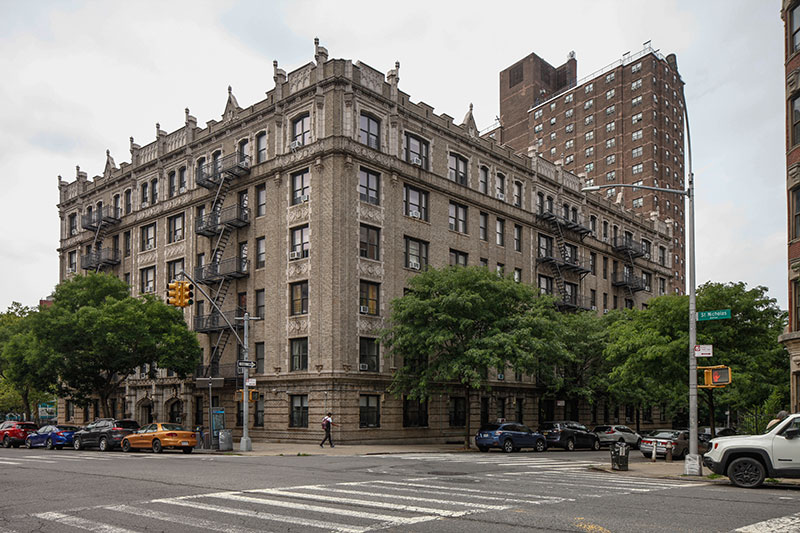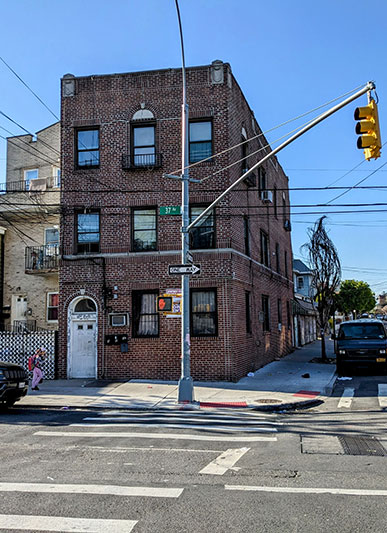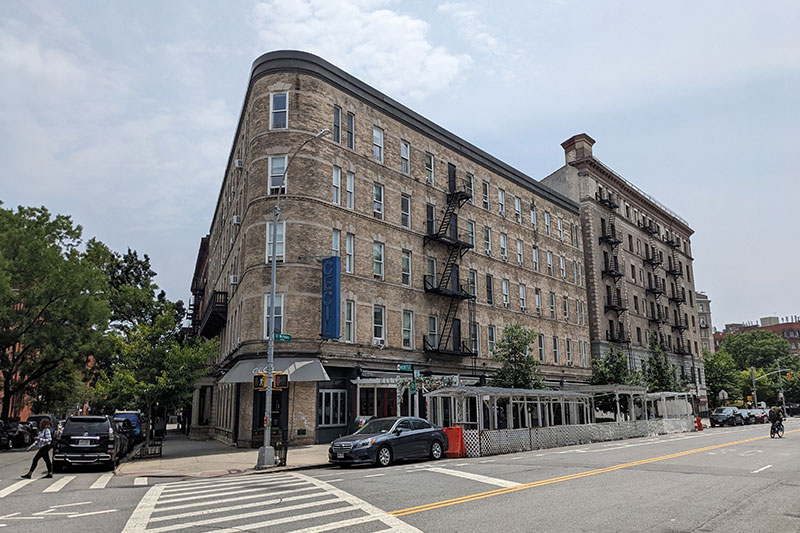
 Landmarks Preservation Commission311
Landmarks Preservation Commission311 Search all NYC.gov websites
Search all NYC.gov websites
Press Release
For Immediate Release: June 27, 2023
Contact: lpcpressoffice@lpc.nyc.gov, 212-669-7938
LPC Designates Three Sites with Ties to Jazz History as Individual Landmarks
935 St. Nicholas Avenue Building in Washington Heights is architecturally significant and the longtime residence of two jazz pioneers, "Duke” Ellington and Noble Lee Sissle
“Dizzy” Gillespie lived at 105-19 37th Avenue in Corona, Queens at the height of his career, using its basement rehearsal studio to collaborate with fellow jazz musicians
Harlem’s Hotel Cecil & Minton’s Playhouse Building is credited with launching the pivotal jazz style of bebop; performances at the famous nightclub helped shape modern jazz
Today’s designations further the goals of the Commission’s Equity Framework and were identified as part of a citywide survey of sites associated with significant Black history



NEW YORK – Today, the New York City Landmarks Preservation Commission (LPC) voted to designate three sites linked to significant people and venues that shaped the sound and trajectory of modern jazz: 935 St. Nicholas Avenue Building in Washington Heights, longtime home of two jazz pioneers, Edward Kennedy “Duke” Ellington and Noble Lee Sissle; the John Birks “Dizzy” Gillespie Residence in Corona, Queens; and Harlem’s Hotel Cecil & Minton’s Playhouse Building. All three sites are considered culturally significant; in designating the 935 St. Nicholas Avenue, the Commission cited its architectural significance, as well.
935 St. Nicholas Avenue in Washington Heights was the longtime home of jazz legends Duke Ellington and Noble Lee Sissle, who were among the most prolific composers, musicians, and bandleaders in American history. Jazz pianist and composer Ellington lived in the building from 1939 to 1961 at the height of his prominent career, while noted ragtime jazz musician and music producer Sissle resided here from 1950 to 1972 during the later part of his career, when he remained a significant and influential figure in the performing arts and was considered the unofficial “mayor of Harlem.”
Dizzy Gillespie purchased the three-story multi-family residence at 105-19 37th Avenue in Corona, Queens at the height of his career in 1953, lived here until 1965, and owned the property until 1985. During this time he recorded several significant albums, served as America’s first jazz ambassador abroad, and his home became a center of Corona’s jazz community. Of the various places he lived in New York City, Gillespie lived in Corona longest, and this home is strongly associated with his significant contributions to jazz and American culture.
The Hotel Cecil was built in 1895-1896 and operated as a residential hotel. From 1941-1961 it was listed in the “Negro Motorist Green Book,” a guidebook that helped direct Black travelers to friendly locations during the Jim Crow era, when openly discriminatory laws allowed businesses to refuse service to the black customers and other people of color. Minton’s Playhouse opened as a nightclub in the hotel’s former dining room in 1938 or 1939, and flourished for more than three decades, gaining fame for its influential house bands, star headliners, and informal jam sessions. It was at Minton’s Playhouse that the style of jazz known as bebop took shape in the 1940s, transforming the direction of American music thanks to informal jam sessions hosted in the nightclub which attracted jazz innovators including legendary jazz trumpeter, composer and bandleader, Dizzy Gillespie.
“The thoughtful recognition of Jazz in New York City and the truly special artists that made the city their home is celebrated today through the Landmarks Preservation Commission’s determination,” said Deputy Mayor for Housing, Economic Development, and Workforce Maria Torres-Springer. “These spaces welcomed Black musicians and allowed them to hone their craft, producing iconic music that lives on today and defines the 24-7 New York experience.”
“Today’s designations reflect the degree to which the history of Jazz is embodied in the very fabric of New York City and recognize the musical pioneers who were drawn to live and work here by the culture of creativity that has always defined our city,” said Landmarks Preservation Commission Chair Sarah Carroll. “The story of Jazz is also the story of the Black community, who built tight-knit communities and cultural institutions in the face of racial discrimination. I’m proud that the Commission has chosen to honor this history and thrilled that these landmarks will be preserved for future generations to come.”
“It is impossible to tell the history of Harlem — and indeed that of New York City and the United States — without imparting the significance of Jazz musicians in the early-to-mid twentieth century,” said New York City Councilmember Shaun Abreu. “Duke Ellington and Noble Lee Sissle were innovators who not only transcended music, theater, and culture with their boundless creativity, but transformed American society as we know it. I could not be more proud to commemorate them by landmarking one of the buildings where they explored and engineered new Black artforms.”
“The Corona East Elmhurst Historic Preservation Society celebrates the Landmarks Preservation Commission’s designation of the John Birks “Dizzy” Gillespie Residence,” said Deborah S. Tyson, one of the group’s founding members. “We are grateful to the Commission, the family of John Birks “Dizzy” Gillespie, the community of Corona and East Elmhurst, the Historic Districts Council, and all who supported our efforts to preserve the Dizzy Gillespie house.”
935 St. Nicholas Avenue holds a prominent place at the corner of West 157th Street and St. Nicholas Avenue in Washington Heights and is a Gothic Revival style brick and limestone apartment building designed by Gronenberg & Leuchtag in 1915. Along with its intact historic architectural character, the building is culturally significant as the long-time home to two jazz trailblazers, Duke Ellington and Noble Lee Sissle.
Jazz pianist and composer Duke Ellington and his family lived in an apartment at 935 St. Nicholas Avenue from 1939 through 1961. During his time in the building, Ellington wrote many songs that have become American jazz standards, including “Sophisticated Lady,” “Satin Doll;” “Don’t Get Around Much Anymore,” and “I Let a Song Go Out of My Heart,” as well as multiple musical suites and music for film and television scores. Many of the accolades and awards Ellington received throughout his illustrious career came during his time on St. Nicholas Avenue, including the cover of Time Magazine in 1956, the Grammy Lifetime Achievement Award in 1966, and the Presidential Medal of Freedom in 1969.
Ragtime jazz musician and music producer Noble Sissle moved into 935 St. Nicholas Avenue in 1950 and lived there until 1972. Sissle rose to prominence with his 1921 musical, Shuffle Along, the first successful Broadway musical with an all-Black cast that introduced such songs as "I'm Just Wild about Harry" (later the campaign song for President Harry S. Truman), “Love Will Find a Way," "Simply Full of Jazz,” and many more. In 1937, Sissle founded the Negro Actors Guild of America, an organization established to try to eliminate the stereotyping of African Americans in theatrical and cinematic performances. During the time he lived at 935 St. Nicholas Avenue, Sissle became known as the unofficial “Mayor of Harlem,” writing many articles for the New York Age and the New York Amsterdam News, and hosting a show on the local New York radio station WMGM.
Dizzy Gillespie purchased 105-19 37th Avenue in Corona, Queens in 1953, during a time when Corona stood in contrast to many Queens neighborhoods in welcoming African Americans, including such notable musicians as Gillespie’s friend Louis Armstrong, who lived around the corner on 107th Street. According to various accounts, Gillespie used the apartment’s basement rehearsal studio as a place of congregation for fellow jazz musicians. Pianist Junior Mance recalled his years in the Gillespie band as "probably my most profound learning experience. “I remember spending several hours at a time in his basement studio being shown chord changes that I never knew existed.”
Gillespie lived at 105-19 37th Avenue, along with his wife and personal manager, Lorraine, during a particularly productive period of his music career. During his years there, Gillespie adopted his signature “bent” trumpet and released or performed on a succession of memorable albums, such as Jazz at Massey Hall (1954), Afro (1954), World Statesman (1956), Manteca (1958) A Portrait of Duke Ellington (1960) and Jambo Caribe (1964). In 1956, Gillespie was chosen by the U. S. State Department to serve as the nation’s first jazz ambassador, a Cold War-era program designed to promote American culture and democratic values. Following his return from a worldwide tour in that role as jazz ambassador, Gillespie appeared on Edward R. Murrow’s “Person to Person”, a CBS interview program that was broadcast live from Gillespie’s Corona home. Gillespie moved to New Jersey in 1966 but retained ownership of the building until 1985.
Today’s third designation, the Hotel Cecil and Minton’s Playhouse Building, is a five-story building designed in the Renaissance Revival style by architect Julius F. Munckwicz, located on the southeast corner of St. Nicholas Avenue and West 118th Street. It offered furnished apartment suites for both long and short-term stays. Due both to its inclusion in the Green Book and the fame of its nightclub, the hotel attracted many Black musicians as guests, including leading jazz, blues, gospel, and soul performers. Trumpeter Miles Davis remembered the Hotel Cecil as “first class … the rates were reasonable, and the rooms were big and clean."
Located on the ground floor with an entrance on West 118th Street, the famed nightclub Minton’s Playhouse was named for its owner, Henry Minton, and managed by bandleader Teddy Hill. In 1941, Hill hired drummer Kenny Clarke, who formed a small house band that included the legendary pianist Thelonious Monk. They played popular songs and accompanied guest singers and soloists, including well-known jazz musicians such as Charlie Christian, Roy Eldridge, Coleman Hawkins, Lester Young, and Ben Webster. On Monday nights, when most Manhattan entertainment venues were closed, Minton’s held open jam sessions where bebop innovators like Dizzy Gillespie and Charlie Parker could drop in and experiment. Gillespie remembered his initial performances at Minton’s as “wonderfully exciting” and as “seedbeds for our new, modern style of music.”
Bebop peaked in popularity after World War II, and Minton’s was frequently credited for playing a significant role. Throughout the 1950s and 1960s, the club continued to present jazz performances, including groups led by, among others, Eddie Lockjaw Davis, Erroll Gardner, Carmen McCrae, and George Benson. Hotel Cecil was damaged by fire in 1974 and Minton’s Playhouse closed. The building was listed on the National Register of Historic Places in 1985, and sensitively refurbished, opening as supportive housing for homeless men and women in 1988. It retains many of its original architectural features, including the entrance to Minton’s Playhouse.
LPC's work is guided by its Equity Framework to ensure diversity and inclusion in designations. All three sites were identified as part of a citywide Commission survey of sites associated with significant Black history, and today’s designations are a direct outcome of that survey effort as the agency continues to prioritize designations that represent New York City’s diversity.
###
Images: Photographs of the sites are available here:
- The 935 St. Nicholas Avenue Building: https://app.box.com/s/hbi9nyuqfdff036d5521jipmxbipw3mk
- The John Birks “Dizzy” Gillespie Residence: https://app.box.com/s/c7td85k5nntcavw4q7gh5fur0ihtoqc3
- The Hotel Cecil & Minton’s Playhouse Building: https://app.box.com/s/wv99oyqnkiyw7ajm3rzt48tnxq365p5j
About the Landmarks Preservation Commission (LPC)
The Landmarks Preservation Commission is the mayoral agency responsible for protecting and preserving New York City’s architecturally, historically, and culturally significant buildings and sites. Since its creation in 1965, LPC has granted landmark status to more than 37,900 buildings and sites, including 1,457 individual landmarks, 121 interior landmarks, 11 scenic landmarks, and 156 historic districts and extensions in all five boroughs. For more information, visit www.nyc.gov/landmarks and connect with us at www.facebook.com/NYCLandmarks and www.twitter.com/nyclandmarks.


